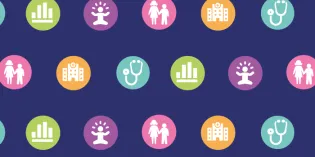Scotland and Northern Ireland already have nation-wide PEWS in place. Summary information on the Scottish PEWS can be found below.
RCPCH is collaborating with NHS England and the Royal College of Nursing to develop a single national PEWS for England as part of the System-wide Paediatric Observation Tracking (SPOT) Programme. The Welsh Patient Safety programme has been engaging with the English SPOT programme with the intention of future collaborations.
This page includes details of what we mean by PEWS, a recording of the RCPCH Conference 2023 session on PEWS, and a summary of details of the Scottish Paediatric Programme and its PEWS. It then has frequently asked questions about the SPOT programme. You can click or tap links on the table of contents to jump to an FAQ.
- What is a PEWS?
- RCPCH Conference 2023: PEWS session
- Scottish PEWS
- 1. How can you get involved or raise queries?
- 2. What is the background to SPOT?
- 3. What is SPOT?
- 4. Which organisations are involved? The SPOT Partnership
- 5. What is the national (England) PEWS chart?
- 6. Why do we need a standardised PEWS?
- 7. What have we learnt so far?
- 8. Does the national PEWS enable parent or carer input?
- 9. How is SPOT being evaluated?
- 10. What does the national PEWS chart contain?
- 11. Where should the national PEWS chart be deployed?
- 12. What is de-implementation?
- 13. What de-implementation issues were raised during the pilot?
- 14. We have no problems with our system. Why should we change?
- 15. Is the national PEWS mandated across England?
- 16. What are the SPOT Educational/Implementation Leads?
- 17. What support will Trusts and staff be given to support implementation of the national PEWS?
- 18. How does paper PEWS differ from digital PEWS?
- 19. How does the eLearning relate to the national PEWS?
- 20. Should we be using the national PEWS in Emergency Departments?
- 21. What other resources might be of interest?
What is a PEWS?
PEWS stands for Paediatric Early Paediatric Early Warning System, which is designed to effectively recognise and respond to the deterioration of children or young people in a healthcare environment. It typically involves an observation chart and track and trigger system, which captures vital signs (heart rate, etc.) or observations (eg work of breathing) to give a total score describing the acuity of the patient and then links the score to specific escalation responses.
It also aims to ensure that in any given clinical environment attention is paid to improving human factor processes of recognition and response. These would include, but aren’t limited to, aspects of communication, visual display, team working, organizational response, etc.
Historically, the ‘S’ of PEWS has sometimes referred to the score contained within this system. The proposed English PEW System contains a PEW Score but also provides a standardised escalation response and suggested communication approaches. When reference is made to PEWS as part of SPOT, this refers to a system rather than the score.
RCPCH Conference 2023: PEWS session
The below recording is from RCPCH Conference in May 2023 in Glasgow. Dr Linda Clerihew and Dr Sonia Joseph outlined the past experience and future plans for PEWS across Scotland. Professor Damian Roland provided an overview of progress with developing a standardised system for PEWS across England through the SPOT programme, while Sarah Scales and Rebecca Wood described their experiences participating in the pilot process for inpatient PEWS as part of the SPOT programme.
Scottish PEWS
The 2023 Scottish Patient Safety (SPSP) Paediatric Programme pulls together resources to support teams in their work to improve the recognition, response and review of the deteriorating child and young person. This includes PEWS charts, a teaching package and webinars outlining how the Scottish PEWS was developed.
The new Scottish Patient Safety Programme for Paediatrics, based upon the Essentials of Safe Care, aims to support teams to improve the recognition, response and review of the deteriorating child and young person. As part of the package of improvement support, the PEWS forms one of the key measurements. It is also used by Excellence in Care to contribute to a national Quality Management Approach which ensures that all NHS boards have consistent, robust processes and systems for measuring, assuring, and reporting on the quality of care and practice.
Further details of these programmes can be found on these links:
- SPSP Paediatric Programme - Resources to support paediatric care
- SPSP - Essentials of safe care
- Healthcare Improvement Scotland - Excellence in care
The following are FAQs.
1. How can you get involved or raise queries?
More information about SPOT is available on the FutureNHS platform at https://future.nhs.uk/SPOT. You'll need to log in, and if you don't yet have an account, follow the links to register with an NHS email address.
For any queries or if you would like to get involved in this work, please contact the National SPOT team at england.pews@nhs.net.
For questions concerning the College's role in the SPOT programme, please contact qips@rcpch.ac.uk.
2. What is the background to SPOT?
Previous work to improve the recognition and response to deterioration in children and young people has rightly focused on improving the whole system response rather than the single component of measurement of observations.
While there is no single national system in England for children and young people, we do not believe this has negatively impacted on the care they receive in hospitals across England. It does, however, present a challenge for the NHS to truly operate as a national system and affects most of our staff who move across sites.
Many acute hospitals have developed their own programmes to improve the recognition and response to deterioration. These have included paediatric early warning scores (PEWS), initiatives and technology for improving the accuracy of taking and recording observations, and the timely escalation of care.
Development across different geographies and clinical settings has created inconsistencies across England. This is unlike other countries, including the devolved nations of Scotland and Northern Ireland, where single PEWS systems for children are in place.
In June 2018, NHS England & NHS Improvement, RCPCH and the Royal College of Nursing (RCN) came together to establish a joint National PEWS Programme Board for England. In 2020, the NHS SPOT (System-wide Paediatric Observations Tracking) Programme was launched, led by the NHS England Children and Young People’s Transformation Programme team.
3. What is SPOT?
SPOT stands for System-wide Paediatric Observation Tracking and is a large programme of work to look at improving the recognition and response to the deterioration of children or young people in any healthcare environment, from a hospital ward to a primary care clinic.
The first phase of the SPOT programme is to standardise an inpatient observation chart and track and trigger system, commonly known as a Paediatric Early Warning System (PEWS), in all English hospitals. The SPOT programme is led by the NHSE CYP Transformation Team and is supported and endorsed by the RCPCH and RCN.
Our ambition is to develop a consistent approach and common language to promptly recognise and respond to the acutely ill or deteriorating infant, child or young person. A paper was published in October 2020 on details of a pre-implementation survey conducted by the programme team for a standardised approach to paediatric early warning systems. In January 2021, the case for change was published in Archives of Disease in Childhood.
4. Which organisations are involved? The SPOT Partnership
We are collaborating with NHS England and the Royal College of Nursing to develop a single national PEWS for England.
Led by the NHS England Children and Young People’s Transformation Team, the System-wide Paediatric Observations Tracking (SPOT) programme launched in 2020, with a programme of research, collaborative development of systems for inpatient PEWS, and development of an eLearning suite to support implementation.
Plans for 2023-25 include releasing of the inpatient paper-based PEWS, consultation and further testing of inpatient digital PEWS, and collaborative testing and development in other healthcare settings, including emergency departments, mental health services, ambulance services and community settings.
The Partnership recognises the complexities in developing and implementing new clinical systems, including the challenges of integrating and decommissioning existing tools and the importance of ensuring patient safety and quality of care.
RCPCH continues to support and endorse the work being carried out by NHS England to lead and implement PEWS as part of the SPOT programme.
5. What is the national (England) PEWS chart?
Supported by the SPOT programme board, an inpatient PEWS chart has been collaboratively developed by clinical teams across England for use on children’s general inpatient wards.
Building on a programme of research and clinical piloting, the paper PEWS chart is published as of 3 November 2023, alongside a summary of the piloting process and an e-learning module.
A digital PEWS is being developed concurrently, with consultation and testing taking place throughout 2023.
Implementation of the paper PEWS chart is being supported through a Community of Practice (see section below), appointed PEWS leads at a Trust level and a national eLearning module available via FutureNHS.
6. Why do we need a standardised PEWS?
England performs poorly compared to other, similar, European nations in relation to childhood mortality (RCPCH, 2014). For example, asthma deaths are much higher than you would expect compared to comparable health systems. The reasons for this are multifactorial but multiple case reviews and national reports identify failure to recognise deterioration as factor.
It is also well recognised that Paediatric Early Warning Systems alone are not a solution in isolation; however, systematic reviews have highlighted their advantages in relation to communication and team working (Roland et al, 2021). A group of experts of multiple professions and specialties met in 2018 and determined a standardised PEWS would provide huge benefits for training, patient care and patient outcomes.
7. What have we learnt so far?
An initial consensus was drawn from a process of reviewing and surveying existing PEWS Charts across England (Roland et al, 2021). Utilising existing evidence and relevant papers an in initial prototype was created to begin testing in October 2021 and has continued until 2023. An executive summary of this testing process is available on the FutureNHS platform, titled SPOT Pilot 2021-3 Executive Summary.
Testing was carried out in 15 sites across England. These sites included District General Hospitals, specialist and children’s hospitals with a mix of digital and paper-based sites. Five sites were asked to participate in initial usability testing (October 2021), followed by the wider cohort of sites being onboarded at prototype 2 and 3. The process of testing was carried out in five phases, iterating five different prototypes of the chart. Each prototype was tested over a number of months for each version, working to saturation point, a thematic analysis of weekly testing collaborative sessions was carried out in order to understand the key themes and issues, informing each iteration of the prototype and wider issues around implementation.
For more information, please visit the FutureNHS platform.
8. Does the national PEWS enable parent or carer input?
Yes, the new national inpatient PEWS includes a parental concern trigger where parental or carer concern will lead to escalation of the child’s care, regardless of other assessments. Alongside the trigger, there is a comment box for staff to note details around any concerns shared. The effectiveness of the design of the parental concern element of the chart will continue to be evaluated and developed as part of ongoing specific parental concern initiatives in a number of pilot sites, and as part of implementation of the national PEWS.
From the outset of the SPOT programme, the partners have recognised the importance of parental voice as a consistent theme. The consensus in the SPOT programme – and the consensus during the panel on PEWS at RCPCH Conference 2023 (see top of page for a recording of this session) – was that parent voice needs to be an essential aspect of escalation systems. In coming years, we intend to extend national early warning systems to aid in the detection of deteriorating children into accident and emergency departments, ambulances and the community as part of the SPOT programme.
Future work will address whether there are ways to enable and encourage children and young people to escalate their concerns. This chart is just the beginning of the process of ensuring we have a comprehensive and well-designed standardised approach to spotting deterioration. The SPOT programme will be exploring how vulnerable cohorts, patient specific cohorts and special cases can best be involved in PEWS.
The National SPOT team are actively engaged in discussions regarding implementation of a future Martha’s Rule and we will ensure that the SPOT programme takes this process into consideration.
9. How is SPOT being evaluated?
Ongoing evaluation is taking place for the inpatient PEWS and wider early warning systems work. The evaluation will include understanding how best to capture parent concern and as a key focus and will look at the impact of the national PEWS implementation.
RAND Europe and THIS Institute are carrying out a project on de-implementation processes in healthcare, learning from the de-implementing of Paediatric Early Warning Systems in England. Further research will uncover the impact of PEWS and explore the potential barriers and facilitators to rolling out a standardised inpatient PEWS tool nationally. This work will inform future version of the PEWS within hospitals and in wider settings. Further details will be available on the FutureNHS platform by the end of 2023.
Reporting and monitoring processes will be put in place to track the progress and development of the national English PEWS.
10. What does the national PEWS chart contain?
The PEWS chart contains multiple elements:
- A PEWS score made up of Heart Rate, Respiratory Rate, Extent of Respiratory Distress, Blood Pressure, Oxygen Saturations, Oxygen Delivery and Capillary Refill Time (CRT)
- Other vital signs and observations, which don’t score but must be recorded, made up of Temperature, AVPU (Alert, Voice, Pain, Unresponsive) and Pain score
- A Parent Concern Trigger
- A Clinical Intuition Trigger
There are four escalation levels (Low, Medium, High, Emergency), which are activated by any of four triggers: the PEWS score, the AVPU level, the Parent Concern Trigger and the Clinical Intuition Trigger.
This allows a child to have a low PEWS score but the nurse reviewing them to escalate on their level of concern alone. It also allows parents to have an independent role if they are concerned about their child.
11. Where should the national PEWS chart be deployed?
The PEWS chart has been designed for use on children’s general inpatient wards.
Working groups have already been established to start aligning the inpatient chart with other clinical environments such as the Emergency Department or in pre-hospital care. The future is to have a common template across all systems (hence this work being part of the SPOT programme). However, while some pilot sites have deployed the National PEWS chart in the Emergency Department, there are some challenges (eg with the need to undertake a Blood Pressure in all patients) and specific task-and-finish groups are reviewing how to optimise its use in this area.
12. What is de-implementation?
It is well recognised by the SPOT team that nearly all hospitals currently have a PEWS in place, which will mean all will have to make adjustments to their current systems.
The nature of standardisation is to ensure a consistency of approach for the overall benefit of the system, but to reach this point will likely mean significant change which can be and feel uncomfortable. At some hospitals the changes will be minimal as the scores will be relatively closely aligned and the only difference will be adding in new mechanisms to escalate (such as via parent/carer concern) but in others there may be more significant alterations.
These changes will need to be carefully governed and it is for this reason that a small amount of resource is available to all sites to all personal to be appointed to assist in this change. This will be cascaded in 2023-24 so that areas have some national funding for supporting early implementation.
13. What de-implementation issues were raised during the pilot?
The SPOT Oversight Group* has identified a number of de-implementation issues in 2023 which are likely to be common across hospitals.
- Parent concern: Evidence supports the engagement of families in the care of their children. Parents, carers and young people involved at the outset of the programme were clear about the need to have an independent route to escalation. There is still much to learn about how we make this process as equitable and sustainable as possible and work in Newcastle, Nottingham and by others will be instrumental in developing this trigger.
- Oxygen delivery: Following considerable discussion it was determined that any form of respiratory support (High Flow Humidified Oxygen, CPAP or BiPAP) will automatically score 4 (the highest possible) for oxygen delivery. We appreciate for some sites that this will appear to falsely elevate the score of some infants who previously would not be deemed to be at higher risk as result of being on High Flow Humidified Oxygen. The view of those on the steering group was that not to score High Flow means the acuity of a patient requiring this intervention is not clearly recognised and that there is a growing issue within hospitals of a lack of awareness of the support that high flow does provide. The unique design of the oxygen delivery section, in that you can track oxygen consumption over time, mitigates the risks of increasing oxygen demand being missed.
- Oxygen saturations: Similar to oxygen delivery, consensus was reached by the expert group that while some children have ‘normally’ abnormal saturations this does represent a potential lower cardiorespiratory reserve, especially when they are unwell enough to be admitted to hospital. For this reason children with congenital cardiac or long term respiratory disease may score at baseline just through the nature of their low saturations. There is no derogation for this as across the system this was felt to represent a risk; however, it is acknowledged in some specialist centres this will represent a change in approach and for some individual patients their acuity profile will change. As more national data is gathered, especially as more sites utilise digital approaches, it will be possible to look at the risk of specific patient groups and amend the scoring system as appropriate.
- Blood pressure: There has been considerable learning at the pilot sites regarding the low rate of blood pressure measurement in children and young people. This is something that will need review at all hospitals as is not in keeping with previously existing advice, particularly from the RCN. A blood pressure is required with all sets of observations; however, in both paper and digital set-ups there is a clear process to be able to record when a blood pressure has not been taken and the reasons for this.
- Escalation: The escalation process may trigger early for many sites, and may be perceived to be poorly specific. The escalation strategy is that once a particular trigger point has reached there needs to be an action; however, at that point a plan can be instituted so that for repeated escalation within the same level it isn’t necessary to have a repeat response.
14. We have no problems with our system. Why should we change?
The national PEWS chart will eventually become the standard of care in England.
This will mean that all medical and nursing students will receive instruction on its use during their training. Sites that are not using the national model will find themselves having to undertake additional training and education and will increasingly be outliers in operational networks (such as intensive care).
As noted in the de-implementation section above we acknowledge that in some areas deployment of the national PEWS may feel like a backward step, but it is a huge step forward for children and young people across England.
15. Is the national PEWS mandated across England?
No, at this stage the PEWS is not mandated.
A Community of Practice will be set up to support areas to embed and implement PEWS (see section on support for Trusts below). In 2023-24 Trusts are expected to appoint an Education/Implementation lead who will begin to support their Trust to roll out the national PEWS.
16. What are the SPOT Educational/Implementation Leads?
Funding has been allocated by NHS England to all Trusts across England with an inpatient paediatric setting. The Inpatient PEWS Educational and Implementation Lead should be a dedicated part of a role, designed to champion the uptake of implementation. Evidence for this role has been drawn from testing and early indications from evaluation. Piloting has shown that it is a pivotal element of implementation and spread/adoption of a new system.
This role is modelled on a hospital based senior nurse role. However, Trusts can use this funding to subsidise a Consultant, Specialist Registrar Lead or any other role deemed appropriate, should they wish. Funding is based on this role dedicating 0.5 PA (programmed activities) a week. Trusts may choose to allocate more time to this role. This role is funded for one year only, to ensure systems have additional leadership for the initial rollout of national PEWS.
This role should include but is not limited to:
- Supporting change management of systems and ways of working across the Trust for inpatient settings
- Leading on training and educational initiatives to support the de-implementation of existing systems and rollout of the national PEWS.
- Participating in the National SPOT Community of Practice for phase 1, inpatients PEWS. The Lead will be expected to share learning from their local experiences and shape the direction of practice recommendations in this area.
- Reporting on progress to their Trust governance mechanisms which will feed into (more detail on reporting requirements will be supplied at launch and via the Community of Practice).
17. What support will Trusts and staff be given to support implementation of the national PEWS?
Trusts will be supported through a Community of Practice, appointed PEWS leads at a Trust level, and a national eLearning module. All Education and Implementation leads should attend the Community of Practice to ensure they are up to date on expectations and share learning and best practice.
The portal on FutureNHS has further information on the System-wide Paediatric Observation Tracking (SPOT) Programme and the work around the National Paediatric Early Warning Score, as well as details of the Community of Practice.
18. How does paper PEWS differ from digital PEWS?
Digital sites will follow a different process to paper-based sites. The digital PEWS will be implemented, guided by a digital specification.
The beta digital specification is published alongside the paper-based PEWS as of 3 November 2023. Consultation on this beta specification took place over summer 2023; however, Trusts can still feedback to the National SPOT team on this beta specification (see FutureNHS platform for more details) The aim to finalise a digital specification in late 2023.
19. How does the eLearning relate to the national PEWS?
An eLearning has been developed and is available on the FutureNHS platform. It is designed to be completed by anyone who may complete or work with a paper-based PEWS.
Areas will be requested to embed this eLearning as part of their wider education and training requirements and sites will be expected to set their own requirements for a compliant workforce (80% recommended).
20. Should we be using the national PEWS in Emergency Departments?
The PEWS chart was specifically designed for children in an inpatient setting. It is not a triage system and has features, such as a mandated Blood Pressure, which are not always required in an emergency setting. Furthermore, as temperature doesn’t score, it can only be used in Emergency Departments that have a separate sepsis scoring mechanism. This is because young infants (less than 3 months) with a fever may be high risk for sepsis but will not score on the chart.
It has always been the aim of the national team to produce an Emergency Department aligned version of the inpatient PEWS chart; however, development, testing and validation of this is going to take at least 12 months. Currently there is also a national review of triage and assessment systems, looking to standardise these in emergency care settings (adult and children) and an Emergency Department PEWS needs to align with this as well.
Hospitals who already have a scoring system in their Emergency Department should continue to use that system.
For Trusts that were looking to replace their current Emergency Department PEWS and/or feel transition from paper to digital models may leave some clinical areas with an inequitable PEWS process we will be producing an interim Emergency Department PEWS chart. This will not have been fully user tested and therefore is not a nationally validated tool. Individual organisations will need to review the risks/benefits of implementing it through their own local governance mechanisms. It should be available in 2-3 months.
21. What other resources might be of interest?
RCPCH Why children die: death in infants, children and young people in the UK (2014)
RCPCH Safe system framework for children at risk of deterioration
RCPCH Situation Awareness for Everyone (S.A.F.E) toolkit
Re-ACT- the Respond to Ailing Children Tool
- *The SPOT Oversight Group comprises expert clinical advisors who have significant experience of developing and researching early warning systems for paediatric settings. For details of membership, please see the SPOT Pilot Executive Summary on the FutureNHS platform (see future.nhs.uk/SPOT)










